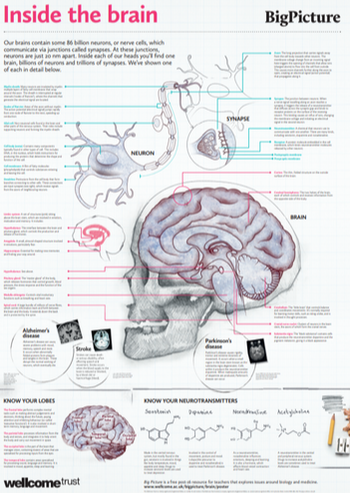
Background: Biochemical, genetic and brain explanations of mental illness
Key Study: Gottesman et al. (2010) Disorders in offspring with two psychiatrically ill parents
Application: Biological treatment of one disorder
Key Study: Gottesman et al. (2010) Disorders in offspring with two psychiatrically ill parents
Application: Biological treatment of one disorder
AO2: Applying the Explanations to Phobias
Phobia = An irrational fear of an object or situation.
Specific phobia = Phobia of a particular object or specific situation e.g. animal types, natural environment types (e.g. heights, water), blood-injection types (e.g. blood, syringes), situational types (e.g. lifts, planes) and other types that do not fit (e.g. clowns, choking).
3 types of characteristics of specific phobias: behavioural, emotional and cognitive.
Phobia = An irrational fear of an object or situation.
Specific phobia = Phobia of a particular object or specific situation e.g. animal types, natural environment types (e.g. heights, water), blood-injection types (e.g. blood, syringes), situational types (e.g. lifts, planes) and other types that do not fit (e.g. clowns, choking).
3 types of characteristics of specific phobias: behavioural, emotional and cognitive.
- Behavioural characteristics: Avoid and Panic
- Emotional characteristics: excessive and unreasonable fear, anxiety and panic.
- Cognitive characteristics: selective attention and irrational beliefs.
The Medical Model in General
AO1: The Medical Model’s View of Mental Illness in General
The medical model views mental illnesses just like other illnesses. They have a physical cause. They can be diagnosed by listing the symptoms. They can be treated by adjusting the physical cause.
There are 3 explanations from the medical model of mental illness:
AO3: Strengths of the medical model include:
The medical model views mental illnesses just like other illnesses. They have a physical cause. They can be diagnosed by listing the symptoms. They can be treated by adjusting the physical cause.
There are 3 explanations from the medical model of mental illness:
- biochemical
- brain abnormality
- genes
AO3: Strengths of the medical model include:
- Not blaming people for their abnormal behaviour. The person’s body has caused the behaviour, not their personality or intentions. This is useful as it has led to more humane treatment of the mentally ill.
- Objective evidence shows that biological causes can be linked to psychological symptoms, such as high dopamine levels in schizophrenia. This helps Psychology to be viewed as a Science, as objective, replicable and empirical methods have been used.
- Psychiatrists such as Szasz see the use of labels, such as ‘mentally ill’ as a way of pathologising people whose behaviour we do not like or cannot explain. This is a problem because the labels are being used for political not helpful reasons.
- There may be problems of concurrent validity in the diagnosis of mental health as there are a range of different diagnostic tools such as the DSM-V and ICD-10. This is a problem as some may be diagnosed and others not.
- There may be problems of inter-rater reliability in the diagnosis, especially as different diagnostic tools such as the DSM-V and ICD-10 are used. A diagnosis should have external reliability – consistency over time, place and people.
- The medical model takes a reductionist approach to mental illness. It ignores the behaviourist, cognitive and psychodynamic factors which may also cause the behaviour. This is problematic as an incomplete explanation of the illness will mean any treatment might not be fully curative.
- The medical model takes a nature not nurture approach to mental illness, especially if genetic explanations are given. This suggests that people are ‘born’ to become mentally ill and this level of determinism means that people may believe there is little or nothing that they can do about it.
- This view is also determinist as it suggests that a chemical imbalance will cause mental illness. However, it can be argued that not all individuals with psychological disorders have abnormal levels of neurotransmitters and not everyone with a chemical imbalance develops a mental illness.
|
The Biochemical Explanation of Mental Illness
AO1: The Biochemical Explanation of Mental Illness
The cause of mental illness is abnormal levels of neurotransmitters. Neurotransmitters are chemicals made by the body. They are released at the end of nerve cells (neurons). This happens an electrical charge has passed along the neuron. They pass across the gap (synapse) between nerve cells. They activate receptors in the next neuron, depending on the quantity required. The neurotransmitters have either excitatory or inhibitory effects on the next neuron. Excitatory (e.g. serotonin) neurotransmitters make the next (post-synaptic) cell more likely to fire. Inhibitory (e.g. GABA) make them less likely to fire. Mental illness can result from too many or too few neurotransmitters binding to receptors. AO2: Getting Empirical Evidence
Pande et al (1999) randomly assigned 69 patients with social phobia to 2 groups:
AO3: Evaluation of the Biochemical Explanation
|
The Brain Abnormality Explanation of Mental Illness
|
AO1: Brain Abnormality as an Explanation of Mental Illness
Different parts of our brain are responsible for different behaviours (localisation of function), and the Medical Model suggest that different mental illnesses may be associated with specific parts of the brain. The cause could be over-activity in the brain leading to excess functioning, or underactivity which could cause deficits in behaviour. AO2: Brain Abnormality as an Explanation of Specific Phobias The prefrontal cortex suppresses (inhibits) the fear response. If the prefrontal cortex is not functioning effectively, it no longer stops fearful urges, like the fight or flight response which are sent from the amygdala. The amygdala detects and responds to threats in the environment. People who suffer from anxiety and phobias have smaller amygdalae and these have greater blood flow. This leads to an inability to control the fear response to objects and situations. AO2: Getting Empirical Evidence
Ahs et al (2009) used PET scans to measure blood flow in the amygdala and prefrontal cortex of patients with snake or spider phobia. They found:
AO3: Evaluation of the Brain Abnormality Explanation of Mental Illness
|
The Genetic Explanation of Mental Illness
 Irving Gottesman
Irving Gottesman
AO1: Genes as an Explanation of Mental Illness
The genetic explanation suggests that:
AO2: Genes as an Explanation of Specific Phobias
Perhaps all humans have inherited, through natural selection, a tendency to fear certain potentially dangerous things e.g. heights. Seligman argues this is because long ago people who did not fear and avoid them, died – so their genes were not passed on
AO2: Gaining Empirical Evidence: Genes as an Explanation of Mental Illness
One way of finding out whether a disorder has a genetic component is to see whether it runs in families. If relatives of sufferers have a higher than average risk of getting the disorder themselves, then it may be that the disorder has a genetic component.
However, family members typically share similar environments. Consequently, increased risk amongst close relative may simply indicate that that are exposed to the same set of environmental risks.
An alternative approach is to do a twin study. This looks at the concordance (similarity) of twins with respect to the disorder being considered. Concordance rates are expressed as a percentage. The percentage is the probability of one twin having the disorder if the other already has it.
In a twin study, MZ (identical) and DZ (non-identical) twins are compared. Whilst MZ twins have a greater degree of genetic similarity, both types of twin pair grow up in identical environments. So if we discover that MZ twins have a higher concordance, this cannot be because their environments are more similar than those of DZ twins; it must therefore be because their genes are more similar.
When interpreting twin study data, we look for the following features:
The genetic explanation suggests that:
- Family and twin studies show some mental illnesses are at least partly caused by innate factors
- People inherit mental illnesses from their parents, through genes
- People with mental illnesses are more likely to have close relatives with mental illnesses too
AO2: Genes as an Explanation of Specific Phobias
Perhaps all humans have inherited, through natural selection, a tendency to fear certain potentially dangerous things e.g. heights. Seligman argues this is because long ago people who did not fear and avoid them, died – so their genes were not passed on
AO2: Gaining Empirical Evidence: Genes as an Explanation of Mental Illness
One way of finding out whether a disorder has a genetic component is to see whether it runs in families. If relatives of sufferers have a higher than average risk of getting the disorder themselves, then it may be that the disorder has a genetic component.
However, family members typically share similar environments. Consequently, increased risk amongst close relative may simply indicate that that are exposed to the same set of environmental risks.
An alternative approach is to do a twin study. This looks at the concordance (similarity) of twins with respect to the disorder being considered. Concordance rates are expressed as a percentage. The percentage is the probability of one twin having the disorder if the other already has it.
In a twin study, MZ (identical) and DZ (non-identical) twins are compared. Whilst MZ twins have a greater degree of genetic similarity, both types of twin pair grow up in identical environments. So if we discover that MZ twins have a higher concordance, this cannot be because their environments are more similar than those of DZ twins; it must therefore be because their genes are more similar.
When interpreting twin study data, we look for the following features:
- MZ concordance is significantly higher than DZ concordance = The disorder has a genetic component
- MZ concordance is same or similar to DZ concordance = The disorder is environmentally caused.
- MZ concordance is 100% = The disorder is genetically caused
- MZ concordance is significantly less than 100% = The disorder has an environmental component
|
|
| ||||||||||||||||||
|
How does the Medical Model Treat Phobias?
AO2 = Application: Biological treatment of one specific disorder
Drugs are a quick way of altering the chemical balance of a person in order to treat the symptoms of a mental illness. Research has shown that drug therapy works faster than both cognitive and behavioural treatments. Benzodiazepines are prescribed for specific phobias. Commonly prescribed benzodiazepines include:
Benzodiazepine is a depressant and slows down the workings of the brain and the central nervous system. They are used medically to reduce anxiety, to help people sleep and to relax the body. They should only be prescribed by a doctor for short periods of time as it is possible to become dependent on them after as little as two weeks’ regular (e.g. daily) use. AO2: Getting Empirical Evidence: Pande et al (1999) randomly assigned 69 patients with social phobia to 2 groups:
AO3: Evaluation Effectiveness – explain whether it is effective or not in treating the abnormalityBZs are effective in treating specific phobias, as shown by Pande et al. Outcome studies – how does the treatment compare with placebosIn the study by Pande et al, the experimental group showed a significant reduction in symptoms compared to the control group. Appropriateness – explain whether or not it is appropriate to use. Refer to:
Side effects of chemotherapies should ONLY be referred in relation to ‘treatment compliance’. Side effects of low doses include:
|

Hodder Education's
Psychology Review Centre Spread on Biological Treatments can be found here |
| ||||||




